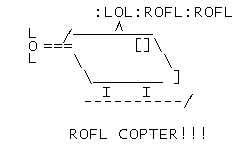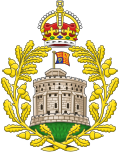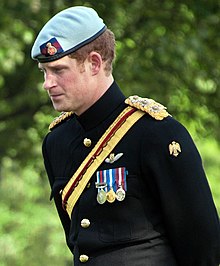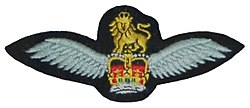LOL
From Wikipedia, the free encyclopedia
This article is about the internet slang abbreviation. For other uses, see LOL (disambiguation).
LOL, an acronym for laughing out loud[1][2] or laugh out loud,[3] is a common element of Internet slang. It was used historically on Usenet but is now widespread in other forms of computer-mediated communication, and even face-to-face communication. It is one of many initialisms for expressing bodily reactions, in particular laughter, as text, including initialisms for more emphatic expressions of laughter such as LMAO[4] ("laugh(ing) my ass off"), and ROTFL[5][6][7][8] or ROFL[9] ("roll(ing) on the floor laughing"). Other unrelated expansions include the now mostly historical "lots of luck" or "lots of love" used in letter-writing.[10]
The list of acronyms "grows by the month"[5] and they are collected along with emoticons and smileys into folk dictionaries that are circulated informally amongst users of Usenet, IRC, and other forms of (textual) computer-mediated communication.[11] These initialisms are controversial, and several authors[12][13][14][15] recommend against their use, either in general or in specific contexts such as business communications.
LOL was first documented in the Oxford English Dictionary in March 2011.[16]
Contents
[hide]Analysis
Laccetti (professor of humanities at Stevens Institute of Technology) and Molski, in their essay entitled The Lost Art of Writing,[12][13] are critical of the terms, predicting reduced chances of employment for students who use such slang, stating that, "Unfortunately for these students, their bosses will not be 'lol' when they read a report that lacks proper punctuation and grammar, has numerous misspellings, various made-up words, and silly acronyms." Fondiller and Nerone[14] in their style manual assert that "professional or business communication should never be careless or poorly constructed" whether one is writing an electronic mail message or an article for publication, and warn against the use of smileys and these abbreviations, stating that they are "no more than e-mail slang and have no place in business communication".
Yunker and Barry[15] in a study of online courses and how they can be improved through podcasting have found that these slang terms, and emoticons as well, are "often misunderstood" by students and are "difficult to decipher" unless their meanings are explained in advance. They single out the example of "ROFL" as not obviously being the abbreviation of "rolling on the floor laughing" (emphasis added). Haig[1] singles out LOL as one of the three most popular initialisms in Internet slang, alongside BFN ("bye for now") and IMHO ("in my honest/humble opinion"). He describes the various initialisms of Internet slang as convenient, but warns that "as ever more obscure acronyms emerge they can also be rather confusing". Bidgoli[17] likewise states that these initialisms "save keystrokes for the sender but [...] might make comprehension of the message more difficult for the receiver" and that "[s]lang may hold different meanings and lead to misunderstandings especially in international settings"; he advises that they be used "only when you are sure that the other person knows the meaning".
Shortis[8] observes that ROTFL is a means of "annotating text with stage directions". Hueng,[5] in discussing these terms in the context of performative utterances, points out the difference between telling someone that one is laughing out loud and actually laughing out loud: "The latter response is a straightforward action. The former is a self-reflexive representation of an action: I not only do something but also show you that I am doing it. Or indeed, I may not actually laugh out loud but may use the locution 'LOL' to communicate my appreciation of your attempt at humor."
David Crystal notes that use of LOL is not necessarily genuine,[18] just as the use of smiley faces or grins is not necessarily genuine, posing the rhetorical question "How many people are actually 'laughing out loud' when they send LOL?". Franzini[2] concurs, stating that there is as yet no research that has determined the percentage of people who are actually laughing out loud when they write LOL.
Victoria Clarke, in her analysis of telnet talkers,[19] states that capitalization is important when people write LOL, and that "a user who types LOL may well be laughing louder than one who typeslol", and opines that "these standard expressions of laughter are losing force through overuse". Egan[3] describes LOL, ROTFL, and other initialisms as helpful as long as they are not overused. He recommends against their use in business correspondence because the recipient may not be aware of their meanings, and because in general neither they nor emoticons are (in his view) appropriate in such correspondence. June Hines Moore[20] shares that view. So, too, does Lindsell-Roberts,[21] who gives the same advice of not using them in business correspondence, "or you won't be LOL".
Spread from written to spoken communication
LOL, ROFL, and other initialisms have crossed from computer-mediated communication to face-to-face communication. David Crystal—likening the introduction of LOL, ROFL, and others into spoken language in magnitude to the revolution of Johannes Gutenberg's invention of movable type in the 15th century—states that this is "a brand new variety of language evolving", invented by young people within five years, that "extend[s] the range of the language, the expressiveness [and] the richness of the language".[22][23]
Geoffrey K. Pullum points out that even if interjections such as LOL and ROFL were to become very common in spoken English, their "total effect on language" would be "utterly trivial".[24]
Conversely, a 2003 study of college students by Naomi Baron found that the use of these initialisms in computer-mediated communication (CMC), specifically in instant messaging, was actuallylower than she had expected. The students "used few abbreviations, acronyms, and emoticons". The spelling was "reasonably good" and contractions were "not ubiquitous". Out of 2,185 transmissions, there were 90 initialisms in total, only 31 CMC-style abbreviations, and 49 emoticons.[23] Out of the 90 initialisms, 76 were occurrences of LOL.[25]
Acceptance
On March 24, 2011, LOL, along with other acronyms, has been formally recognized in an update of the Oxford English Dictionary.[16][26] In their research, it was determined that the earliest recorded use of LOL as an initialism was for "little old lady" in the 1960s.[27] They also discovered that the oldest written record of the use of LOL in the contemporary meaning of "Laughing Out Loud" was from a message typed by Wayne Pearson in the 1980s, from the archives of Usenet.[28]
Gabriella Coleman references "lulz" extensively in her anthropological studies of Anonymous.[29][30]
Lexical form
The past tense of lol is lolled. The participle form is lolling.
Variations on the theme
| For a list of words relating to for Internet laughter slang, see theInternet laughter slangcategory of words in Wiktionary, the free dictionary. |
Variants of LOL
- lul: phonetic spelling of LOL
- lolz: Occasionally used in place of LOL.
- lulz: Often used to denote laughter at someone who is the victim of a prank, or a reason for performing an action. This variation is often used on the Encyclopedia dramatica wiki and 4chan image boards. According to a New York Times article about Internet trolling, "lulz means the joy of disrupting another's emotional equilibrium."[31] Can be used as a noun — e.g. "do it for the lulz.", shortened into "ftlulz" (to distinguish it from "ftl" - "for the lose").[32][33] See also LulzSec.
- lolwut (sometimes "lulwut"): lol + wut, used to indicate bemused laughter, or confusion.
- Lawl or Lal: Pseudo-pronunciation of LOL. Saying "lawl" is sometimes meant in mockery of those who use the term LOL, and is not meant to express laughter.
- LOLOLOLOL: For added emphasis, LOL can be appended with any number of additional iterations of "OL". In cases such as these, the abbreviation is not to be read literally (i.e., "Laughing out loud out loud out loud out loud"), but is meant to suggest several LOLs in a row.
- trolololol or trollololol: A portmanteau of troll and LOL iterated. Indicates that the prank or joke was made by internet trolls, or the user thinks the prank or joke qualifies as internet trolling. See also Mr. Trololo.
- LMAO: For "Laughing my ass off".[4] Variant: LMFAO ("Laughing my fucking ass off").
- ROFL: For "Rolling on the floor laughing". It is often combined with LMAO for added emphasis as ROFLMAO ("Rolling on the floor laughing my ass off"). Variant: ROTFL.[34]
- Roflcopter: A portmanteau of ROFL and helicopter. The term was supposedly first used by a Blizzard Entertainment moderator in the Warcraft III forum in 2003.[citation needed]
- lqtm: For "Laughing quietly to myself".[35]
- *G* or *g*: For "grins".[36] Like "lulz" it is used in the initialism "J4G" ("just for grins").[37]
- Emoticons: To express funny expressions
Commonly used equivalents in other languages
Most of these variants are usually found in lowercase.
- mdr: Esperanto version, from the initials of "multe da ridoj", which translates to "lot of laughs" in English.
- mdr: French version, from the initials of "mort de rire" which roughly translated means "died of laughter", although many French people also use LOL instead as it is the most widely used on the internet.[38][39]
- חחח/ההה: Hebrew version of LOL. The letter ח is pronounced 'kh' and ה is pronounced 'h'. Putting them together (usually three or more in a row) makes the word khakhakha or hahaha (since vowels in Hebrew are generally not written), which is in many languages regarded as the sound of laughter.
- 555: the Thai variation of LOL. "5" in Thai is pronounced "ha", three of them being "hahaha".
- asg: Swedish abbreviation of the term asgarv, meaning intense laughter.
- g: Danish abbreviation of the word griner, which means "laughing" in Danish.[40]
- rs: in Brazil "rs" (being an abbreviation of "risos", the plural of "laugh") is often used in text based communications in situations where in English LOL would be used, repeating it ("rsrsrsrsrs") is often done to express longer laughter or laughing harder. Also popular is "kkk" (which can also be repeated indefinitely), due to the pronunciation of the letter k in Portuguese sounding similar to the ca in card, and therefore representing the laugh "cacacacaca" (also similar to the Hebrew version above).[41]
- mkm: in Afghanistan "mkm" (being an abbreviation of the phrase "ma khanda mikonom"). This is a Dari phrase that means "I am laughing".
- 哈哈哈/呵呵呵: in Chinese. Although 大笑 (da xiao; "big laugh") is used, a more widespread usage is "哈哈哈" (ha ha ha) or "呵呵呵" (he he) on internet forums. The phonetic rendering, "haha", is also common.
- ههههه: in Arabic is a repetition of the "ه" character meaning "Hahahaha" or "Hehehehe". "ه" is equivalent to the letter "H", while the "a" (or "e") is treated as an implied short vowel, and isn't written (as is standard in Arabic and Hebrew).[citation needed]
- (笑): in Japanese, the kanji for laugh (笑) is used in the same way as lol. It can be read as kakko warai (literally "parentheses laugh") or just wara. w is also used as an abbreviation, and it is common for multiple w to be chained together.[42]
- ㅋㅋㅋ ("kkk") and ㅎㅎㅎ ("hhh") are usually used to indicate laughter in Korean. 'ㅋ', is a Korean Jamo consonant representing a "k" sound, and 'ㅎ' represents an "h" sound. Both "ㅋㅋㅋ" and "ㅎㅎㅎ" represent laughter which is not very loud. However, if a vowel symbol is written, louder laughter is implied: 하하 "haha" 호호, "hoho." [43]
- ha3: Malaysian variation of LOL. ha3 means pronouncing ha three times, "hahaha".
- jajajá: in Spanish, the letter "j" is pronounced /x/.[44]
- jejeje: in the Philippines is used to represent "hehehe". "j" in Filipino languages is pronounced as /h/, derived from the Spanish /x/. Its origins can be traced to SMS language. It is widely used in a Filipino youth subculture known as Jejemons.[45][46]
In some languages with a non-Latin script, the abbreviation LOL itself is also often transliterated. See for example Arabic لــول and Russian лол.[citation needed]
Pre-dating the Internet and phone texting by a century, the way to express laughter in morse code is "hi hi". The sound of this in morse, 'di-di-di-dit di-dit, di-di-di-dit di-dit', is thought to represent chuckling.[47][48]
The word "lol" in other languages
- In Dutch, lol is a word (not an acronym) which, coincidentally, means "fun" ("lollig" means "funny")
- In Welsh, lol means "nonsense" – e.g., if a person wanted to say "utter nonsense" in Welsh, they would say "rwtsh lol"[49]













